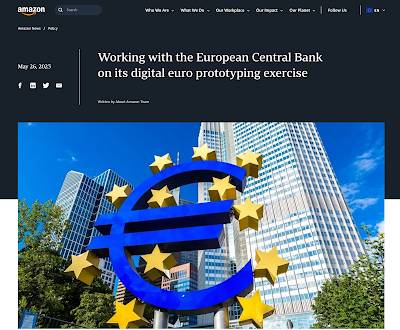
Amazon and the Digital Euro – Promoting its Own Profitability at Our Expense
Here is a recent announcement from Amazon:
In the article with the subtitle “We at Amazon believe that a digital euro can be a tool to foster innovation and increase the efficiency of payments“, the company announces the release of a report by the European Central Bank which outlines the lessons learned from the ECB’s prototyping exercise which ran from July 2022 to February 2023 for the digital euro. Of course, Amazon is all excited about this development since it was chosen to participate in the exercise by delivering a prototype of an e-commerce transaction ecosystem and integrate it into the Eurosystem’s payment system. Amazon states the following:
“At Amazon we were proud to have been part of this exercise, during which we were able to offer the ECB our expertise from an ecommerce payments perspective. We are invested in enabling modern, fast, and inexpensive payments for our customers, and we believe our customer obsession lends itself to maximising convenience, speed, and security. Our involvement in the project further illustrates our commitment to Europe, where we directly employ more than 200,000 people across the continent, support 225,000 European small and medium enterprises through our stores, and have spent €142 billion to grow Amazon across the EU since 2010.”
Typically, when it comes to promoting digital currencies, it’s all about convenience, speed and security. That’s how our dystopic future is being sold to the sheeple.
According to the ECB’s recent report on the prototype of the digital euro, the exercise included the development of a single back-end (i.e. settlement engine) and five different front-end (i.e. user interfaces) prototypes which were presented by private companies, including Amazon, CaixaBank, Worldline, EPI and Nexi. Each of the proposed user interfaces was tailored to one of the five proposed person-to-person payment uses for the digital euro which include payments that are conducted:
(i) person-to-person online payments
(ii) person-to-person offline payments initiated in shops where there is no need for network connectivity
(iii) point-of-sale payments initiated by the payer
(iv) point-of-sale payments initiated by the payee
(v) e-commerce payments
It is the E-commerce payments option that Amazon was selected to study.
According to the report, the tests proved that the Eurosystem payment system was capable of supporting different types of transactions while protecting users’ privacy by not revelling their payment patterns or account balances to the Eurosystem.
Here is a key quote from the report that I found interesting with my bold:
“In line with the Eurosystem’s objectives, it was possible to deepen the understanding of the technical characteristics of offline payment systems, building on the knowledge already gained from the previous experiments conducted by the Eurosystem in 2021. However, questions remain as to whether the existing technology is capable of delivering, in the short to medium term (five to seven years), a production-ready and secure offline solution in line with the Eurosystem’s requirements and on the scale foreseen for the digital euro.“
That’s the first time that I’ve ever seen a timeline for adoption of CBDCs announced by any of the world’s major central banks.
Let’s close this posting with a quote from Amazon’s article:
“We appreciate the ECB’s diligence in working with various stakeholders to ensure a digital euro works in practice, and we are optimistic that the new public infrastructure will deliver significant benefits to EU residents, merchants, and the broader EU economy.”
Of course Amazon is optimistic that the implementation of a digital euro would deliver “significant benefits”, mainly to its own profitability. To hell with the rest of us.

Be the first to comment